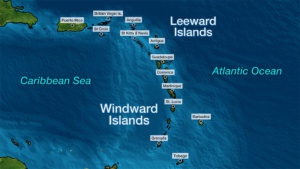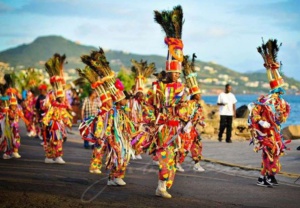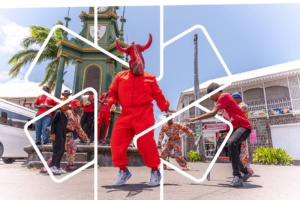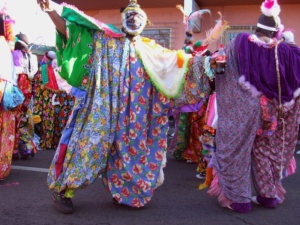Location
 The Federation of St. Kitts and Nevis is located in the Eastern Caribbean at 17 20 North, 62 45 West, roughly 1,200 miles from Miami, 1,600 miles from New York, 4,000 miles from London and about 45 minutes by plane from Puerto Rico and the US Virgin Islands.
The Federation of St. Kitts and Nevis is located in the Eastern Caribbean at 17 20 North, 62 45 West, roughly 1,200 miles from Miami, 1,600 miles from New York, 4,000 miles from London and about 45 minutes by plane from Puerto Rico and the US Virgin Islands.
Geographic Data
St. Kitts is approximately 18 miles long and 5 miles wide with an average area of 65 square miles. The Island of St. Kitts is 6.2 miles away from Sint Eustatius to the north and 1.9 miles from Nevis to the south. St. Kitts has three distinct groups of volcanic peaks: the North West or Mount Misery Range; the Middle or Verchilds Range and the South East or Olivees Range. The highest peak is Mount Liamigua, formerly Mount Misery, a dormant volcano approximately 1,156 m high.
Nevis is conical in shape with a single volcanic peak, 985 m high, known as Nevis Peak. Both St. Kitts and Nevis bear their highest peaks at central points on the islands. The peaks are surrounded by tropical rainforest and these areas are mostly uninhabited. Majority of the population on both islands live along the coast.
Population
54, 821*
Governments & Politics
 The Federation of St. Kitts & Nevis is a constitutional monarchy. Our head of state is the Queen of St. Kitts & Nevis who is also Queen of Britain, Canada and a number of other countries around the world. Every act of government is done in the Queen’s name but the authority for every act flows from the people of St. Kitts & Nevis. We have a Cabinet responsible to Parliament and a Parliament answerable to the People.
The Federation of St. Kitts & Nevis is a constitutional monarchy. Our head of state is the Queen of St. Kitts & Nevis who is also Queen of Britain, Canada and a number of other countries around the world. Every act of government is done in the Queen’s name but the authority for every act flows from the people of St. Kitts & Nevis. We have a Cabinet responsible to Parliament and a Parliament answerable to the People.
Government impacts on all aspects of our lives and understanding how it works is important to every citizen of St. Kitts & Nevis. The following sections provide a brief overview of the structure and process of our government, the institutions and symbols that represent it, and the people to whom we have entrusted it.
The Prime Minister is the Head of Government of St. Kitts and Nevis. There is a House of Assembly headed by a Speaker of the House. Elections are held every five years.
St. Kitts and Nevis have a single National Assembly responsible for making laws, and comprising fifteen (15) members. Eleven (11) of these are directly elected representatives whilst three (3) are senators appointed by the Governor-General – two on the advice of the Prime Minister and the third on the advice of the leader of the opposition. The Attorney General, who was not appointed as a senator, automatically gets a seat as one, increasing the number of senators to four. Of the eleven (11) elected members, eight represent constituencies in St. Kitts and the remaining three in Nevis.
The Prime Minister is appointed from the representatives by the Governor General, who has a constitutional duty to select someone who is likely to command the support of the majority of the representatives. In practice this would normally mean the leader of the majority party or coalition. If there is no suitable candidate, then the governor general can dissolve the assembly and trigger a general election. Other ministers are also appointed by the Governor General, on the advice of the Prime Minister (and so effectively by the Prime Minister). The Prime Minister can be removed from office by the assembly or by the Governor General if he feels that the Prime Minister no longer enjoys the support of the majority of representatives. The assembly is elected every five years unless the Governor General dissolves it before the end of this period, which he may do on the advice of the Prime Minister.
Culture
Culture is the combination of the arts, beliefs and institutions created by a group of people that share common geography. Here on the Islands of St. Kitts and Nevis, our culture provides a fascinating window into the distant past, and yet it is seems to be evolving right before our eyes. It is a rare treasure chest of traditions and customs brought together from very different lands by very different people. You can see it in the way we dance, taste it in the way we cook, and hear it in the stories we tell.
A beloved tradition
One of the most cherished traditions in our treasure chest of cultural riches is our carnival at Christmas time, when our Clowns, Moko-Jumbies, Masquerade, Bull, and Actors parade in a joyous display of island pride. Culturama, the annual cultural festival of Nevis, is celebrated during the Emancipation Day weekend, the first week of August. The festivities include many traditional folk dances, such as the masquerade, the Moko jumbies on stilts, Cowboys and Indians, and Plait the Ribbon, a May pole dance.
The Art of Masquerade
 In St. Kitts and Nevis, Masquerade is an art form. Uniquely Kittitian and Nevisian, it is the grand display of our festivities, a cultural evolution that has taken place over the course of 300 years. Paraders wear tall peacock-feathered headdresses, masks, and fringed aprons that reach just above the knees. The entire costume is decorated with bangles, mirrors and ribbons.
In St. Kitts and Nevis, Masquerade is an art form. Uniquely Kittitian and Nevisian, it is the grand display of our festivities, a cultural evolution that has taken place over the course of 300 years. Paraders wear tall peacock-feathered headdresses, masks, and fringed aprons that reach just above the knees. The entire costume is decorated with bangles, mirrors and ribbons.
Dance experts have identified elements of European and African genres, which include the “Wild Mas”, the Waltz, Quadrille, the Rhumba, the Fertility Dance, the Fine Dance, the Jig and the Boillola. The “Quadrille”, which has its roots in 17th-Century France, is the first dance. It is a slow, structured couple’s dance. The second dance, the “Fine”, picks up the pace. It demands greater skill as the dancers work their way, on one foot, towards each other in the centre of the ring. There they perform a Fertility Dance that is traceable to the mating dance of Africa.
The real spectacle comes when the masquerades break into a frenzy of “Wild Mas”, throwing their tomahawks into the air. This dance is typical of the African war dance that has been performed over millennia. The next dance is the “Jig”. Here the dancers display their skill with the tomahawk, with their right foot hooked behind their left.
This dance follows right into the “Boillola”, another dance movement where the tomahawk is held between the dancer’s legs, while the dancers jump and clap to the music, moving from side to side. European roots are put on parade when the dancers pair off into couples and perform the Waltz to a moderately fast triple meter.
Moko-Jumbies and African mythology
Once a year African mythology brilliantly comes to life and walks among us on St. Kitts and Nevis. Dressed in long colorful gowns, Moko-Jumbies dance on six to eight foot stilts to the delight of everyone along the parade route. Although we may never know for certain, many theories surround their costumes and the dance they perform. One theory is that Moko is the name of the African God of Vengeance. Others believe it is a corruption of the word macaw, the name of a very tall palm tree covered with thorns, since the headpieces of Moko-Jumbies resemble the heart of the macaw plant when it is in full bloom.
Beware of the Bull
 Don’t worry. That’s just a Kittitian or Nevisian dressed in red with a bull headdress coming down the street. And when he goes into a wild frenzy causing chaos and havoc, he’s only retelling the story of an incident that happened at the Belmont estate back to 1917. As it is told, the prize bull of that property’s manager fell ill, only to miraculously revive. It is this revival that is acted out in graphic detail causing humor and havoc as the bull runs wild among spectators.
Don’t worry. That’s just a Kittitian or Nevisian dressed in red with a bull headdress coming down the street. And when he goes into a wild frenzy causing chaos and havoc, he’s only retelling the story of an incident that happened at the Belmont estate back to 1917. As it is told, the prize bull of that property’s manager fell ill, only to miraculously revive. It is this revival that is acted out in graphic detail causing humor and havoc as the bull runs wild among spectators.
Bring in the Clowns!
 For hundreds of years our Clowns have been a big part of our cultural festivals. This troupe of up to fifty players wear floppy, colorful costumes decorated with tiny bells that fill the air with a delightful jingle. The punctuating crack of the Hunter, a leather whip carried by each performer, serves to keep them in sync with the rhythms of their accompanying String Band. In the same tradition of all local folk dances, our clowns wear pink wire mesh masks to hide their identity and allow for total lack of inhibition. As they serpentine behind and between each other, the elegance and grace of this fun-loving flock of Kittitians and Nevisians is truly a spectacle to behold.
For hundreds of years our Clowns have been a big part of our cultural festivals. This troupe of up to fifty players wear floppy, colorful costumes decorated with tiny bells that fill the air with a delightful jingle. The punctuating crack of the Hunter, a leather whip carried by each performer, serves to keep them in sync with the rhythms of their accompanying String Band. In the same tradition of all local folk dances, our clowns wear pink wire mesh masks to hide their identity and allow for total lack of inhibition. As they serpentine behind and between each other, the elegance and grace of this fun-loving flock of Kittitians and Nevisians is truly a spectacle to behold.
For All Other Ministries please visit: http://www.gov.kn Or http://www.nia.gov.kn/
